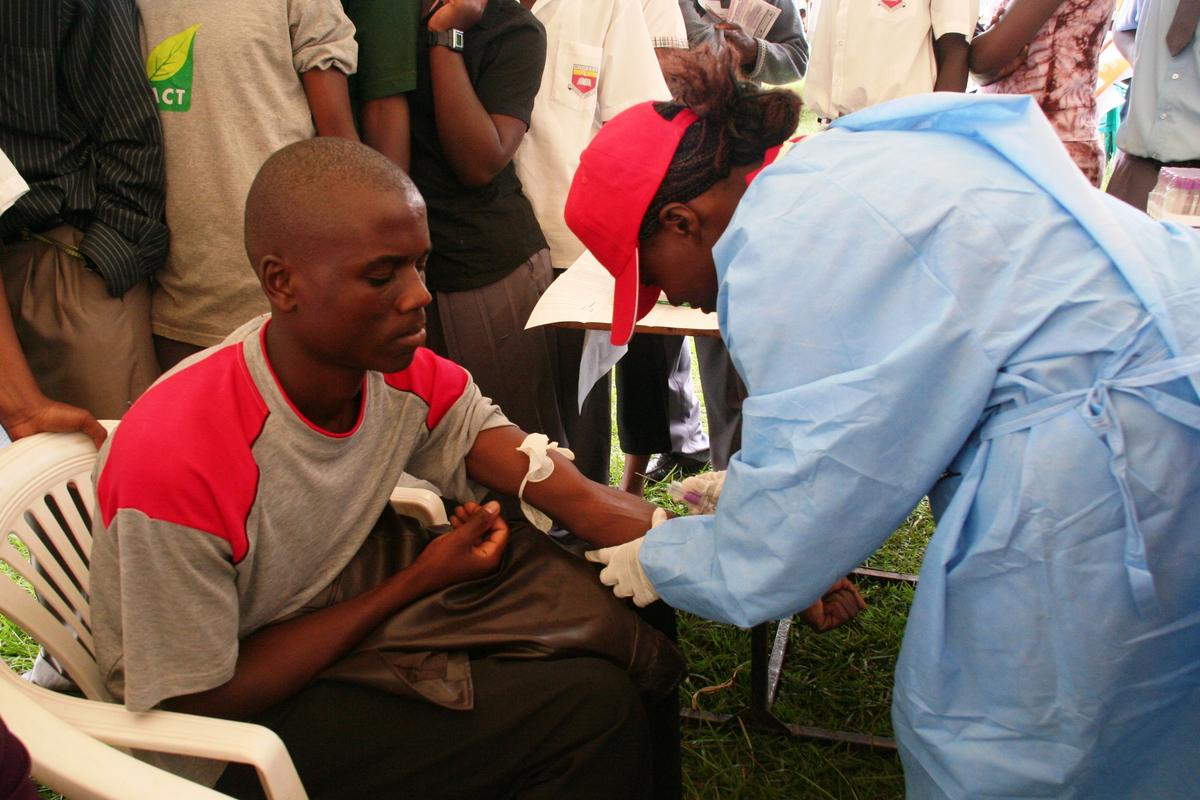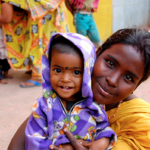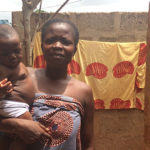Improving Outcomes for Men Along the HIV Treatment Continuum

A nursing aide in Masaka, Uganda, administers an HIV test to a participant in a community HIV/AIDS awareness event. © 2012 Uganda National Volunteers Link, Courtesy of Photoshare
A significant number of men do not seek or have access to HIV testing and counseling (HTC) or treatment in sub-Saharan Africa. Several studies have shown that women have higher rates of testing, engagement in pre-ART care, earlier treatment initiation, and are more likely to stay on treatment.[1] [2] [3] [4] [5] [6] Men continue to access care at later stages of HIV-infection.[7] A global review based on 36 studies found that being a heterosexual male was a consistent risk factor for presenting with low CD4 counts, resulting in worse outcomes for men once enrolled in treatment.[8] Additional evidence demonstrates that once men initiate ART, they often have lower retention and worse treatment adherence.[9]
Numerous barriers prevent men from seeking services along the treatment continuum. Gender norms are important determinants of decisions to undergo HTC and subsequent progression through the HIV care pathway.[10] Men avoid health facilities due to the belief that going to them displays weakness, embarrasses them, and compromises their leadership position – all potentially degrading internal perceptions of masculinity.
As countries move to test and treat, many more men who test positive who are asymptomatic and newly diagnosed will be encouraged to initiate treatment. In several studies, men demonstrate worse engagement in the care continuum if there are no symptoms or when they doubt disease severity.[11] [12] [13] [14] The additional challenges of reaching men who may not be immediately ready to start treatment are likely to persist and may be further amplified.
The evidence outlined above makes a clear case for the unmet needs of HIV positive men. Existing service delivery models must be coupled with robust community-based programs that respond to the preferences of men and encourage dialogue among them while providing compelling messages related to overall wellness and the benefits of engagement throughout the treatment continuum.
The Health Communication Capacity Collaborative (HC3) will therefore undertake a comprehensive intervention to engage men more effectively across the treatment continuum. Through a multifaceted approach utilizing a community platform, HC3 will actively promote messages specific to men’s needs focused on early engagement in care re-framing service-seeking in an empowering way that builds on the male client’s strengths. A focus on improving disclosure, addressing stigma and providing post-test support will be done as well. Testimonials from male PLHIV and other channels will also be used to amplify male voices as fellow role models who are successfully navigating the treatment continuum.
The intervention will be coupled with a robust evaluation as well. HC3 will report on findings in 2017 and share the learning broadly.
Join HC3 for a webinar on Tuesday, May 17 at 9 AM EDT, When the Evidence Is Not Enough: Hormonal Contraception and HIV
References
[1] Bassett IV, Regan S, Chetty S, Giddy J, Uhler LM, Holst H, et al. (2010) Who starts antiretroviral therapy in Durban, South Africa?. . . not everyone who should. AIDS 24 Suppl 1: S37–44. doi: 10.1097/01.aids. 0000366081.91192.1c PMID: 20023438
[2] Geng EH, Bwana MB, Muyindike W, Glidden DV, Bangsberg DR, Neilands TB, et al. (2013) Failure to initiate antiretroviral therapy, loss to follow-up and mortality among HIV-infected patients during the pre-ART period in Uganda. J Acquir Immune Defic Syndr 63: e64–71. doi: 10.1097/QAI. 0b013e31828af5a6 PMID: 23429504
[3] Geng EH, Nash D, Kambugu A, Zhang Y, Braitstein P, Christopoulos KA, et al. (2010) Retention in care among HIV-infected patients in resource-limited settings: emerging insights and new directions. Curr HIV/AIDS Rep 7: 234–244. doi: 10.1007/s11904-010-0061-5 PMID: 20820972
[4] Druyts E, Dybul M, Kanters S, Nachega J, Birungi J, Ford N, et al. (2013) Male sex and the risk of mortality among individuals enrolled in antiretroviral therapy programs in Africa: a systematic review and meta-analysis. AIDS 27: 417–425. doi: 10.1097/QAD.0b013e328359b89b PMID: 22948271
[5] Auld, A. F., et al. “Lower Levels of Antiretroviral Therapy Enrollment Among Men with HIV Compared with Women-12 Countries, 2002-2013.” MMWR. Morbidity and mortality weekly report 64.46 (2014): 1281-1286.
[6] Nyamhanga, T., Muhondwa, E., & Shayo, R. (2013). Masculine attitudes of superiority deter men from accessing antiretroviral therapy in Dar es Salaam, Tanzania. Global Health Action, 1-9.
[7] Hoffman S, Wu Y, Lahuerta M, Kulkarni SG, Nuwagaba-Biribonwoha H, El Sadr W, et al. Advanced disease at enrollment in HIV care in four sub-Saharan African countries: change from 2006 to 2011 and multilevel predictors in 2011. AIDS. 2014;28:2429–38.
[8] Mukolo, Abraham, et al. “Predictors of late presentation for HIV diagnosis: a literature review and suggested way forward.” AIDS and Behavior 17.1 (2013): 5-30.
[9] Bor, J., Rosen, S., Chimbindi, N., Haber, N., Herbst, K., Mutevedzi, T., . . . Barnighausen, T. (2015). Mass HIV Treatment and Sex Disparities in Life Expectancy: Demographic Surveillance in Rural South Africa. PloS Med, 1-21.
[10] Kikaya, V., Skolnik, L., Garcia, M., Nkonyana, J., Curran, K., & Ashengo, T. (2014). Voluntary Medical Male Circumcision Programs Can Address Low HIV Testing and Counseling Usage and ART Enrollment among Young Men: Lessons from Lesotho. PloS, 1-5
[11] Ochieng-Ooko, Vincent, et al. “Influence of gender on loss to follow-up in a large HIV treatment programme in western Kenya.” Bulletin of the World Health Organization 88.9 (2010): 681-688.
[12] Talnan, E and EngenderHealth. “Masculinité, Normes de Genre et VIH/SIDA en Côte d’Ivoire. “ Littérature review. (2011)
[13] Zachariah, R., et al. “Retention and attrition during the preparation phase and after start of antiretroviral treatment in Thyolo, Malawi, and Kibera, Kenya: implications for programmes?.” Transactions of the Royal Society of Tropical Medicine and Hygiene 105.8 (2011): 421-430.
[14] Govindasamy, Darshini, Nathan Ford, and Katharina Kranzer. “Risk factors, barriers and facilitators for linkage to antiretroviral therapy care: a systematic review.” Aids 26.16 (2012): 2059-2067.








Leave a Reply
Want to join the discussion?Feel free to contribute!